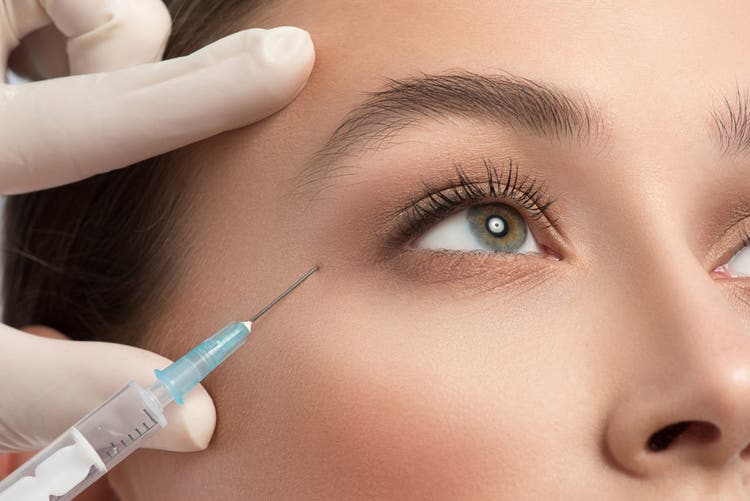Ask the Experts: Your Burning Questions About Botox, Answered

Botox, the cosmetic injection that was wildly popular in the ‘90s and then got a bad rap for making people look expressionless or triggering adverse reactions, is back and better than ever. But there remains confusion about its uses and benefits, so 24Life asked the experts for more insight.
Meet the experts

Dr. Anthony Youn, board-certified plastic surgeon and assistant professor of surgery at the Oakland University William Beaumont School of Medicine, has been in private practice for 15 years. His complete skin-care and laser center specializes in cosmetic surgery and holistic plastic surgery—treating a patient as an overall whole, including diet, skin care, environmental, toxicities and exposure, and using surgery as an absolute last resort. Author of “The Age Fix” (Grand Central Life & Style, April 2016) and “In Stitches: A Memoir” (Gallery Books, April 2011), Youn’s third book called “Playing God: The Evolution of a Modern Surgeon” (Post Hill Press) drops in September, and he is working on his fourth book, a holistic anti-aging guide. Youn also hosts a podcast called “The Holistic Plastic Surgery Show.”
Laura Altman is a physician assistant who began her career working in cardiac surgery and now specializes in cosmetic injectables including Botox and dermal fillers. Altman worked as a PA for Dr. Oz for a decade before transitioning to the world of aesthetic medicine. She is currently working at Tribeca MedSpa, where she sees patients.

What is Botox?
“Botulinum toxin A (Botox) is a neurotoxin that was originally used to treat eye spasms. What they found was that the wrinkles went away as a side effect,” Altman says. “When Botox is injected into the muscle, it relaxes muscle movement. Muscle movement causes skin creases, which create wrinkles and lines.”
“Every year, according to the Aesthetics Society, upward of 5 million people in the United States undergo Botox injections,” Youn says. “Botox has revolutionized cosmetic medicine because you can get impressive results through a needle and not necessarily through a scalpel. It truly is the simplest and easiest wrinkle-reducing treatment there is.”
How long does Botox last?
Botox is only a temporary fix—lasting about three to six months, depending on your metabolism, Altman says.
So how does Botox work, and where does it go?
Botox is injected into the muscle to relax its movement, and it takes approximately two to four days for the muscle weakening effect to take place and about 10 days for maximum results to be seen.
It’s affecting the release of the neurotransmitter acetylcholine that activates the muscle,” Altman explains. “There is a reaction that happens that blocks this acetylcholine from being released therefore the muscle does not get activated. So it takes some time for the channels to be blocked. And then naturally your body metabolizes it.”
Botox isn’t just used to treat the crow’s-feet around the eyes or forehead wrinkles, Youn explains. It’s also being used to smooth the skin and reduce pore size and is being injected into the armpits and hands to reduce sweating—some neurologists are even recommending Botox as treatment for migraines. “On average, and it seems like every month or two, we’re finding a new potential avenue of treatment for it,” Youn says.
Does it hurt?
“We use tiny little needles. Some people experience more discomfort than others,” Altman says. “Regardless, it’s a very minimal and brief discomfort. The procedure takes about 5 to 10 minutes.”
There is a risk of bruising, Altman continues. “So if you have any important events that evening, you may not want to do Botox,” she advises. “We do recommend avoiding any blood thinners such as alcohol, aspirin, vitamin E, fish oil and NSAIDS (non steroidal anti-inflammatory) such as ibuprofen, Aleve and Advil for 5 to 7 days before getting Botox. And taking arnica tabs a couple of days before could help prevent the bruising.”
How much is too much?
“Too high of a dosage actually freezes the muscles and doesn’t allow any movement,” Altman says. “There are guidelines that Allergan has created with what an average dose per area could be. But those can be drastically changed depending on the individual—how strong their muscles are and what results they want.”
For new patients, Altman recommends starting with a conservative dose. Because you don’t see the effects of Botox right away, she prefers to inject the lowest possible dose initially and wait to see the results before adding more if the effect is not sufficient. “You can always add more, but you can’t take it away,” she says. Then you know that patient’s dose for next time.
Youn echoes Altman and adds that it’s important to only get Botox done by a board-certified plastic surgeon or a board-certified dermatologist.
“We know the anatomy, and we treat a patient artistically,” he says. “Any doctor can buy Botox and inject it. There are doctors who treat Botox like an assembly line. You walk in the door, the doctor stabs you a bunch of times, and [you] walk out the door. That’s not going to be artistic—you want to see how the person’s face moves. You want to make sure that you’re injecting the appropriate amount.”
Fillers vs. Botox—what’s the difference?
Unlike Botox, derma fillers are injectables for volume loss—not wrinkles. Fillers don’t relax the muscles. Instead, hyaluronic acid fillers are implanted into specific areas on the face to create the volume lost as we age. And while fillers last much longer than Botox, they are also more expensive—and come with a higher risk of complications.
“You can get lumps from fillers. You can get infections from fillers that you can’t get with Botox,” Youn says. “If it’s accidentally injected into a blood vessel, it can occlude that blood vessel, and that can cause issues such as scarring, loss of tissue. The most severe of all complications is people have actually gone blind from improperly injected filler. That does not happen with Botox.”
While there is an enzyme that can dissolve fillers if an undesirable result occurs, Altman warns that you should do your homework before seeing a practitioner for dermal filler injections.
“You need to make sure that you’re with an experienced injector who understands anatomy because there is a risk of injecting into a blood vessel, creating some blockages in circulation,” Altman says.
What’s your professional take on Botox?
“I think it’s a great treatment to be used prophylactically, not just to treat once you have lines but to keep those lines from forming,” Altman says.
Youn agrees and says that his No. 1 priority for patients is to make sure they understand what Botox is for—and what it’s not. “Make sure that you’re realistic with what you want to treat,” he says. “I get people who come in and say, ‘I want Botox because I’ve got jowls.’ Well, it doesn’t do anything for a jowl.”
Is it “healthy” or “unhealthy”?
While Botox is not a naturally occurring substance in the body, Youn and Altman both agree that the tiny doses used to relax the muscles are completely safe.
“We don’t know of any major complications from Botox, short term, long term, if it’s injected according to the FDA guideline,” Youn says.
“It’s minimally invasive,” Altman agrees. “There have been studies done, and none have shown long-term problems with small doses of Botox.”
Why do you think Botox is more widely used nowadays?
Both Youn and Altman agree that the stigma against cosmetic procedures has drastically declined in the last few decades.
“I think it’s because it’s so widespread and it’s so easy,” Youn says. “People have been having it done for a very long time. I think as social media has become more and more popular, people are feeling more open to sharing things that maybe were taboo in the past. More and more people are having it done, but I think even almost more important than that is more and more people are admitting they’re having it done.”
How can we ensure Botox doesn’t negatively impact our mindset surrounding our physical appearance?
“We want girls to grow up with a realistic understanding of what aging is and that perfection is not always beauty,” Altman says. “Some social media posts are over the top and so unrealistic. I think some people who are going to get Botox, they may have some unrealistic expectations. But in our office, we discuss what is realistic and what is not realistic. And a lot of people these days do know about social media and being able to alter photographs, and they don’t believe everything they see anymore.”
“When you look at it really from a mindset perspective, there’s two things to consider here,” Youn says. “The first thing is there are studies that show that injections of Botox can help improve depression. We’re not exactly sure why. It’s possible it may have something to do with the fact that when you get Botox, it’s hard to make an angry face—and there are studies that show that the act of smiling releases certain endorphins or hormones that cause you to feel better. The second part of it is, there is this whole idea that when we feel good about how we look, it causes us to feel better and even sometimes happier inside. It’s not a cure for depression. It’s not a cure for low self-esteem or poor self-image, but it’s like putting on a new shirt and getting a feeling of ‘Wow, I feel good.’”
What are more natural ways than Botox to prevent wrinkles and aging of the face?
Stay out of the sun and wear sunscreen, Altman advises. “There are certain skin-care products that can also help. Antioxidants can help combat free-radical damage to the skin. Chemical peels, micro-needling and laser resurfacing can help with reversing some of that damage” she adds.
Youn also advises using an anti-aging cream—even when you’re young—like a retinol moisturizer, exfoliating your skin a few times a week, and if you want to splurge, try dermaplaning or red light therapy.
“I have a free e-book on my website, “What to Eat to Look Younger.” Go on there and leave an email, and we’ll email it to you for free,” Youn says.
Here are Youn’s top four tips:
- Eat the rainbow. “The pigment that causes that color of fruits and vegetables is what the actual antioxidants are, so by eating the rainbow, you get a wide variety of antioxidants that fight free radicals and oxidation, a necessary way to fight premature aging.”
- Eat anti-inflammatory foods. “So colorful fruits and vegetables but also eating healthy omega-3 fats. No farm-raised fish, ideally wild-caught fish, like wild-caught salmon, has great omega-3 fatty acids in it. Nuts and beans are also great sources of omega-3 fatty acids. Try to choose grass-fed beef, eggs from free-range chickens. Those have fewer omega-6 fatty acids, which are inflammatory, and more omega-3s.
- Avoid dairy. “I am not a fan of dairy. I think dairy is inflammatory toward your skin, so I recommend people reduce their dairy.”
- Stay away from sugar. “The No. 1 thing is to reduce the amount of sugar that you eat because sugar is a great ager of the skin.”
Photo credit: YakobchukOlena, iStock